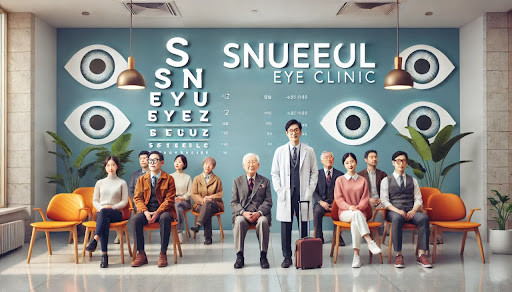The field of ophthalmology has seen remarkable technological growth in recent years. From smart diagnostic tools to innovative surgical procedures, modern vision science is transforming how we diagnose, snu eye clinic treat, and even prevent eye diseases. These breakthroughs are not only enhancing clinical outcomes but also offering hope to millions of people affected by vision impairment worldwide.
In this article, we explore the latest advances in ophthalmology and vision technology that are shaping the future of eye care.

1. Artificial Intelligence (AI) in Eye Diagnostics
AI and machine learning are revolutionizing how eye diseases are detected and monitored. Advanced algorithms can now analyze retinal images with impressive accuracy—sometimes on par with or better than trained specialists.
Key Applications:
- Diabetic Retinopathy Screening: AI-powered systems like Google’s DeepMind can detect early signs of diabetic retinopathy and macular edema from retinal scans.
- Glaucoma Monitoring: AI tools analyze optic nerve images to track subtle changes over time, helping to prevent vision loss.
- Triage and Decision Support: AI is assisting doctors in prioritizing high-risk patients and making faster, more informed decisions.
These technologies reduce diagnostic errors, streamline workflow, and expand access to care—especially in underserved areas.
2. Gene Therapy for Inherited Retinal Diseases
For patients with genetic eye conditions like Leber congenital amaurosis or retinitis pigmentosa, gene therapy is offering newfound hope. In 2017, the FDA approved Luxturna, the first gene therapy for a genetic eye disease.
How It Works:
A harmless virus delivers a healthy copy of the faulty gene directly into the retina, restoring function in photoreceptor cells. Some patients have experienced improved light sensitivity and even regained navigation abilities in low-light settings.
With numerous clinical trials underway, gene therapy is emerging as a powerful tool to address previously untreatable inherited eye disorders.
3. Smart Contact Lenses and Wearable Tech
Smart lenses are no longer science fiction. Researchers are developing contact lenses embedded with miniature sensors and microelectronics that can monitor eye health and enhance vision.
Potential Functions:
- Glucose monitoring through tears for people with diabetes
- Drug delivery directly into the eye for chronic conditions
- Augmented reality (AR) display for vision enhancement
- Intraocular pressure monitoring for glaucoma patients
While most of these are still in development, companies like Mojo Vision and Google are actively investing in this cutting-edge technology.
4. Minimally Invasive Glaucoma Surgery (MIGS)
Glaucoma is the leading cause of irreversible blindness globally. Traditional surgery can be risky, but MIGS procedures offer safer, less invasive alternatives.
Benefits of MIGS:
- Shorter recovery time
- Lower complication risk
- Can be combined with cataract surgery
Devices like iStent, Hydrus Microstent, and XEN Gel Stent improve aqueous outflow and reduce intraocular pressure, making glaucoma management more effective and less burdensome.
5. Retinal Implants and Bionic Eyes
For individuals with profound vision loss from retinal degeneration, retinal implants—often referred to as bionic eyes—offer a glimpse of restored sight.
Example:
The Argus II Retinal Prosthesis System uses a camera mounted on glasses to send visual information to a microelectrode array implanted in the retina. While the resolution is still limited, patients can distinguish shapes, motion, and objects—dramatically improving independence.
Ongoing research aims to improve image quality and expand applications to conditions like macular degeneration.
6. Optogenetics and Vision Restoration
Optogenetics is a cutting-edge technique that involves genetically modifying retinal cells to respond to light. This approach has shown promise in restoring partial vision to patients with complete retinal degeneration.
How It Works:
By using light-sensitive proteins from algae or bacteria, scientists can reprogram surviving retinal cells to detect light—even when native photoreceptors are damaged.
In a recent clinical trial, a blind man with retinitis pigmentosa was able to identify and locate objects using special glasses that projected images onto his modified retina. This field holds enormous potential for the future of vision restoration.
7. 3D-Printed Corneas and Artificial Tissue
Corneal blindness affects over 10 million people globally. Donor shortages remain a significant barrier to treatment, but 3D printing is emerging as a solution.
Recent Progress:
Scientists have successfully printed human corneal tissue using bio-inks made of stem cells and collagen. These lab-made corneas could one day be customized for each patient and eliminate the need for donor tissue.
Researchers are also exploring synthetic corneas and tissue scaffolds to repair damaged areas and promote natural healing.
8. Teleophthalmology and Remote Eye Care
The COVID-19 pandemic accelerated the adoption of telemedicine across all medical fields, including ophthalmology.
Applications:
- Remote eye screenings using smartphone-based fundus cameras
- Virtual consultations for triaging and monitoring
- AI-powered platforms for home-based vision tests
Teleophthalmology improves access to care in rural or underserved regions and helps manage chronic eye conditions more efficiently.
Final Thoughts
From gene therapy and artificial intelligence to smart lenses and retinal implants, ophthalmology is at the forefront of medical innovation. These technological advances are not just improving treatments—they’re redefining what’s possible in preserving and restoring vision.
As research continues and new solutions reach the market, patients can look forward to safer surgeries, more accurate diagnoses, and even restored sight in once hopeless cases. The future of eye care is bright—and it’s only getting clearer.